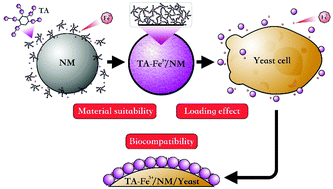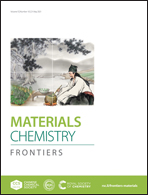Insight into the tannic acid-based modular-assembly strategy based on inorganic–biological hybrid systems: a material suitability, loading effect, and biocompatibility study†
Abstract
The tannic acid (TA)-based modular-assembly strategy has exhibited great prospects for fabricating inorganic–biological hybrid systems recently, albeit the technique is still at the early stage of development. Herein, we investigate this strategy in different aspects, including the material suitability, loading effects, and biocompatibility. The successful functionalization of InP nanoparticles, Bi nanospheres, and g-C3N4 by TA–Fe3+ nanofilm and their subsequent modular assembly onto the yeast surface demonstrated the good versatility of this approach toward the different types of nanomaterials. The proper utilization of TA and nanomaterials in the surface-functionalization step was found to be critical for the material-loading effect, which could also be negatively impacted by the excessive amounts of TA and Fe3+ in the modular-assembly process. The biocompatibility of TA–Fe3+-functionalized nanomaterials to living cells could be optimized via adjusting the relative ratio of TA to nanomaterials during the functionalization. A balance between the material loading and biocompatibility could also be achieved via fine-tuning the TA concentration in the biohybrid studies. The presented deep insight into the TA-based modular-assembly strategy would allow the rational construction of inorganic–biological hybrid systems with a feasible pathway for the development of solar-to-chemical conversion technology, and also for the development of microbe-mediated drug delivery, tumor treatment, and environmental remediation.



 Please wait while we load your content...
Please wait while we load your content...